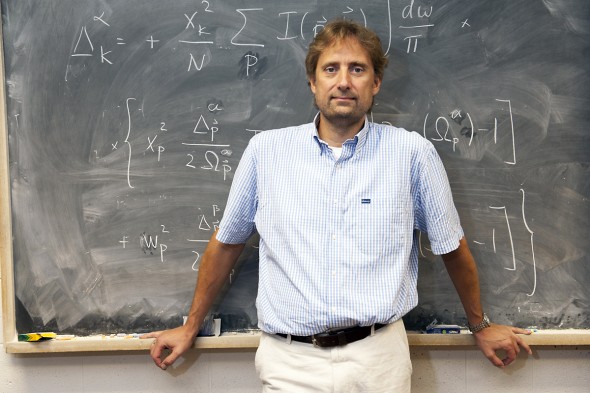Superconductors key to expanding energy technology

Physics professor Dirk Morr studies superconductors, which can transport energy over vast distances. Photo: Roberta Dupuis-Devlin/UIC Photo Services
Arizona has lots of sun, but Chicago has cold gray winters — so how do we transport energy generated by solar power or wind power to where it’s needed, without the massive losses that current energy transport entails?
Delivering energy sustainably and economically is a major stumbling block in attempts to expand alternative energy technology.
Superconductors, which can transport energy over vast distances without any losses, could be the perfect solution, says Dirk Morr, professor of physics.
But energy transport without energy loss only occurs at a superconductor’s critical temperature, most commonly close to absolute zero (-460 degrees Fahrenheit).
A class of unconventional superconductors with much higher critical temperatures was first discovered in 1986. Although their critical temperatures are still far too cold (in the range of -160 degrees Fahrenheit) to be of practical use, these high temperature superconductors seem to work through a different mechanism.
For thise reason, some scientists believe it will be possible to find materials that can act as superconductors at room temperature.
In a collaboration led by Morr at UIC and Seamus Davis at Cornell University, reported in Nature Physics, researchers have taken an important step toward understanding the basic physics of unconventional superconducting material — the type of superconductor that has the most promise for room temperature superconducting and practical applications.
Working with an unusual superconductor that has a low critical temperature — just above absolute zero — but physical properties like those of the higher temperature unconventional superconductors, the researchers gained important insight into the mechanism that makes higher temperature superconducting possible — what the physicists call its “quantum glue.”
“I think that what we have now found and described in this article is the first step towards the ideal of a room-temperature superconductor,” Morr said.
“We can say that we have observed something that allows us to make an educated guess as to what the quantum glue [of these high-temperature superconductors] is.
